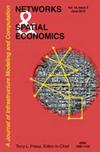Productivity, Subsidies, and Agricultural Specialization: Evidence from the Russian Far East
IF 1.5
3区 工程技术
Q3 OPERATIONS RESEARCH & MANAGEMENT SCIENCE
引用次数: 0
Abstract
Are the effects of subsidies on farm productivity heterogeneous? Does the direction and magnitude of subsidies impact depend on farm specialization? To address this question, I use farm-level data from Amur region in the Russian Far East for 2010–2014. The data set includes farms inputs and output as well as state subsidies and degree of farm specialization. The latter is defined as the share of crop production in total farm revenue. The sample of farms is not random but includes almost the entire set of corporate farms in the Amur Region. Using the data, I estimate the production function that allows me to study the relationships between total factor productivity (TFP), farms specialization and state subsidies. To test whether farm specialization moderates the impact of subsidies on TFP, an interaction term between specialization and subsidies was included in the model. So, I study how the marginal effects of subsidies change conditional on degree of specialization. My findings support the heterogeneous effect of subsidies on TFP depending on the degree of farm specialization. High degree of specialization on livestock production is associated with negative effects of subsidies on TFP, while I don’t fine a statistically significant connection between subsides and TFP for farms specializing on crop production. The research contributes to the discussion about the effects of state supports and subsidies on agricultural development and productivity in Russia and particularly in the Russian Far East生产率、补贴和农业专业化:来自俄罗斯远东地区的证据
补贴对农业生产率的影响是否存在异质性?补贴影响的方向和程度是否取决于农业专业化?为了解决这个问题,我使用了俄罗斯远东地区阿穆尔河地区2010-2014年的农场数据。该数据集包括农场的投入和产出,以及国家补贴和农业专业化程度。后者被定义为农作物产量在农业总收入中所占的份额。农场的样本不是随机的,而是包括了阿穆尔河地区几乎所有的公司农场。利用这些数据,我估计了生产函数,使我能够研究全要素生产率(TFP)、农场专业化和国家补贴之间的关系。为了检验农业专业化是否会调节补贴对全要素生产率的影响,我们在模型中加入了专业化与补贴之间的交互项。因此,本文研究了补贴边际效应如何随专业化程度的变化而变化。我的研究结果支持补贴对全要素生产率的异质性影响,这取决于农业专业化程度。畜牧业生产的高度专业化与补贴对TFP的负面影响有关,而我没有发现专门从事作物生产的农场的补贴与TFP之间存在统计学上显著的联系。该研究有助于讨论国家支持和补贴对俄罗斯农业发展和生产力的影响,特别是在俄罗斯远东地区
本文章由计算机程序翻译,如有差异,请以英文原文为准。
求助全文
约1分钟内获得全文
求助全文
来源期刊

Networks & Spatial Economics
社会科学-运筹学与管理科学
CiteScore
4.00
自引率
4.20%
发文量
26
审稿时长
>12 weeks
期刊介绍:
Networks and Spatial Economics (NETS) is devoted to the mathematical and numerical study of economic activities facilitated by human infrastructure, broadly defined to include technologies pertinent to information, telecommunications, the Internet, transportation, energy storage and transmission, and water resources. Because the spatial organization of infrastructure most generally takes the form of networks, the journal encourages submissions that employ a network perspective. However, non-network continuum models are also recognized as an important tradition that has provided great insight into spatial economic phenomena; consequently, the journal welcomes with equal enthusiasm submissions based on continuum models.
The journal welcomes the full spectrum of high quality work in networks and spatial economics including theoretical studies, case studies and algorithmic investigations, as well as manuscripts that combine these aspects. Although not devoted exclusively to theoretical studies, the journal is "theory-friendly". That is, well thought out theoretical analyses of important network and spatial economic problems will be considered without bias even if they do not include case studies or numerical examples.
 求助内容:
求助内容: 应助结果提醒方式:
应助结果提醒方式:


